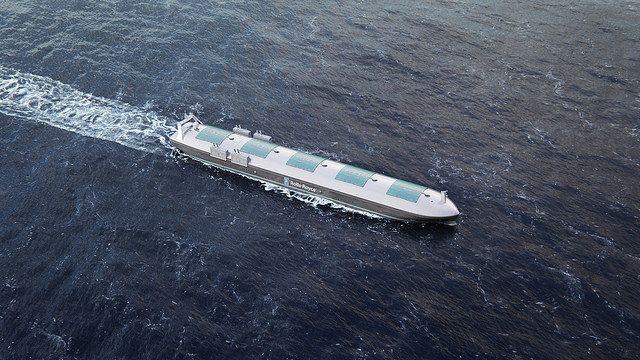Remote-controlled ships could hit the high seas within a decade.
While they might end up putting sailors out of a job, fully autonomous boats could help the fossil fuel-hungry shipping industry drastically slash its carbon emissions.
Staffing a ship with a full crew requires lots of energy. Sailors need food, water, onboard sewage treatment facilities, air conditioning and heating. They also add weight to the vessel, slowing it down. Without a crew on board, a cargo ship could run on 10 to 15 percent less fuel and cut its carbon emissions by a similar percentage, according to Oskar Levander, vice president for innovation at Rolls Royce, which is developing autonomous ships with researchers at VTT Technical Research Centre of Finland.
“The primary benefits of remote and autonomous vessels will be improved efficiency and safety,” Levander told the blog Climate Home. “Obviously anything that makes ships more efficient in terms of energy consumption also has the potential to reduce emissions.”
The first driverless boats were developed by the United States Navy and tested in 2014. The Navy designed its fleet of remote-controlled "swarm boats" to carry out risky missions without a crew, keeping sailors away from the line of fire.
Driverless cargo ships, by contrast, would be responsible mostly for steaming across the ocean, docking, loading or unloading cargo, then steaming on to the next port. And Rolls Royce says its researchers are perfecting the technologies needed to remotely steer ships through the high seas.

Shipping goods by sea accounts for between 2 and 3 percent of global carbon emissions -- equivalent to the annual carbon output of Germany. That number could jump to 14 percent by 2050, according to Bill Hemmings, aviation and shipping policy director at Transport and Environment, a group advocating for sustainable industry policies.
The quickening pace of global economic growth is driving the rise in shipping emissions. During the 2008 recession, global trade slowed to a crawl, and ships literally cut their speeds to conserve fuel. Now, as the economy rebounds, cargo ships are completing voyages faster and more frequently, increasing their carbon output, said Hemmings.
"The easiest way to make a ship more efficient is to slow down," Hemmings told The Huffington Post. "What we all fear is when the economy picks up, average ship speeds are going to pick up and emissions will skyrocket again."
Pollutants emitted by cargo ships, along with emissions from the aviation industry, have been a bone of contention during international climate negotiations. At the December climate talks in Paris, 196 countries pledged to reduce their carbon emissions in a bid to keep planetary warming under two degrees Celsius above pre-industrial levels, but the deal didn't include the shipping or aviation sectors.
By leaving those two industries out of the agreement, countries have made it much harder to meet the agreed-upon warming targets.
"If shipping and aviation don’t start reducing, these two sectors are going to gobble up whats left of the carbon budget," Hemmings added.
For large cargo ships, cutting carbon emissions can be tough. Most ships still rely on bunker fuel, the heaviest, dirtiest fuel on the market. Some military vessels run on nuclear power, but it's too risky for commercial boats. Ships could potentially run on lower-carbon ethanol or hydrogen fuel cells, but companies have so far shown little interest in switching.
So, shipping companies and researchers are experimenting with ways to make fossil fuel-powered vessels more efficient, said Hemmings. In an effort to cut the amount of fuel ships needs to complete their journey, they're testing high-tech sails, streamlined hulls and "bulbous bows," which reduce drag as ships slice through the water.
Rolls Royce's remote-controlled ship is only the latest in a string of efforts to improve ship efficiency. It remains to be seen how well it actually works.
"Whether autonomous ships will be significant, I don’t know," Hemmings said.

Airplanes are already highly automated. But there's little evidence that taking humans out of the cockpit would do much to cut carbon emissions. Most attempts to clean up the aviation industry have involved swapping jet fuel for cleaner alternatives. Researchers have also developed fully electric and hybrid-electric airplanes, including planes that run exclusively on solar power.
The shifting regulatory landscape could give remote-controlled ships a boost. Until this year, cargo ships didn't have to report how much fuel they used. Companies that wanted to hire efficient ships weren't able to charter those vessels simply because they didn't know how much fuel each ship burned, according to Hemmings.
That changed in April, when the International Maritime Organization adopted a measure requiring ships weighing more than 5,000 metric tons to report how much fuel they use. The new reporting rules could help countries and shipping companies demand that ships clean up their act, according to Hemmings.
"Once we’ve measured fuel burn of ships, then maybe we could have an efficiency standard," Hemming said. "If you have autonomous ships that are efficient, they would fare well under that regime."
